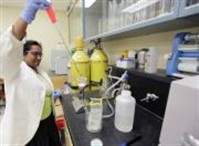Solutions around the bend
April 2009
by Fred Afflerbach – Telegram Staff Writer
The latest Lampasas River checkup says the 75-mile waterway needs to go on a diet and get to the gym more often. That’s how Steve Potter, a research scientist at the Blackland Research & Extension Center in Temple, described the river.

Dr. Rajani Srinivasan of Blackland Research & Extension Center in Temple tests for coliform in Lampasas River water. Researchers are studying the Lampasas and Leon rivers, both listed as impaired for bacteria. –photo by Scott Gaulin/Telegram
“It’s more like you go to the doctor … and you don’t need a triple bypass, but you need to lose a little weight, you need to watch your eating and you need to start exercising,” Potter said. “You need to take care of those little things now, and in 15 years we’ll be OK.”
In 2004, the Texas Commission on Environmental Quality rated the Lampasas River “impaired.” This means it has elevated bacteria levels, nutrient problems in isolated areas, and low oxygen in at least one location.
Potter is piloting this joint effort among several Texas AgriLife departments, and other environmental and water districts and authorities. He’s employing an all-inclusive approach, looking for input from city and county officials, outdoorsmen and landowners.
One such landowner, Bradley Ware, can trace his roots along the Lampasas back to the 1870s. Today, the family property includes two miles of river frontage. His father once drank freely from the clear-running water, but today, the son won’t. Ware says he’s seen too much foamy water flowing past – and too many old tires, water heaters and old refrigerators – to feel comfortable ingesting Lampasas River water in the 21st century.
Cleaning up the river is like swimming upstream, he said.
“If we can stabilize it where it’s at, we’ll be doing good. From my perspective, from the old way, it’s urban development coming in (causing problems). When I was a kid, places were being divided up in 200 and 500-acre places. Now, they’re being divided up into five and 20 acres. So we got that many more people in here,” Ware said.
With more people, comes more discharge from water treatment plants, and a higher number of septic systems, which could leak into the watershed. Another concern is domestic and wild animal feces.
A former Brazos River Authority board member, Horace Grace, monitors water issues through his role as Clearwater Underground Water Conservation District president. Although the district is responsible for managing aquifer and well water, river water quality is a concern because the systems are connected. Contaminated river water seeps in the ground and could affect well water.
Regarding the Lampasas, Grace says it’s important to bring all parties to the table, from the lone angler or swimmer, to landowners like Ware, to cities that depend on Stillhouse Hollow water for drinking.
“There is an answer, but you got to have fair-minded people, sitting down at the table, stakeholders discussing how can we resolve these issues,” Grace said. “Because we are going to be the ones who suffer, if there is some degradation, or if there is an outbreak of some disease. We need to look at the science.”
Interested parties all say this is a long-term project. Research scientist Potter believes these type projects often fail because people don’t follow through.
“We developed this plan, but we’ve also developed the next step,” Potter said. “We’re going to look at this thing on a longer term than three years. You have to do it forever. It’s a permanent thing.”
The Lampasas meanders from the upper reaches of Hamilton County, through Stillhouse Hollow Lake and empties into the Little River in Central Bell County.
River study funding comes from the U.S. Environmental Protection Agency, Texas State Soil and Water Conservation Board and Texas AgriLife Research.
–Reprinted with permission of Temple Daily Telegram
